CHINESE RETAIL BUSINESSES
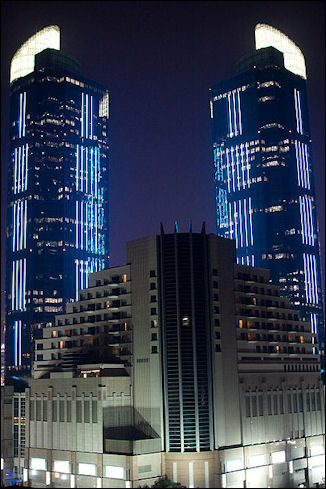
Xujiahui Grand Gateway Shanghai China is the world’s fastest-growing major retail market, and may one day be the biggest. Retail sales in China are expected to reach $5 trillion and outstrip those of the United States by 2016 according to former Japanese commerce official Huang Hai. Some predict that China will surpass the United States as the largest consumer market before 2020.
China's retail sales are currently growing at 9 percent to 15 percent a year (depending on how you interpret the data) which offers serious long-term growth opportunities to those companies who know how to exploit the Chinese market. Retail sales rose 14 percent to $770 billion in 2006 and 17 percent to $1.2 trillion in 2007. Still that is only a quarter of the retail sales in the United States. The retail sales are expected to rise to $2.4 trillion by 2020. The Chinese government finds the growth encouraging as it tries to reduce its dependence on exports and investment for growth.
The Economist reported: “Retail sales in China are $1 trillion a year and growing by around 18 percent annually. China’s 1.4 billion people are rapidly urbanising and ravenous for all the goods they couldn’t have a generation ago. Their government is eager to promote domestic consumption. But the Chinese middle class is not nearly as rich as the middle class in developed countries. A mere 1.4 percent of urban households make more than $15,000 a year, and only 11 percent make $5,000-15,000. And all these people save furiously, because unless they work for the state they are unlikely to receive much of a pension. [Source: The Economist, May 19, 2011]
Chinese retailers are doing well in Shanghai. Shanghai Hualian runs a chain of 1,200 stores. Lianhua. Convenience and Supermarket Company opened up 350 stores alone in 2002. Beijing is not so wide open. The markets there are dominated by state-owned enterprises and retailers that operate in different districts.
Suning is China's largest retailer, with about 1,300 stores. It aggressively expanded in 2010 to take the ranking away from Gome. Gome Electrical Appliance was the top retailer in China in 2006 with sales of around $10 billion. It has has 700 outlets in 2010 cities (See Below). Beijing Wangfujing was the 11th largest department store chain in the Asia-Pacific region in 2005 based on returns. Home-improvement malls, the Chinese equivalent of Home Depot, are large spaces filled with hundreds of small outlets selling everything for the home. These are run by Jinsheng Group.
Articles on CHINESE BUSINESS, TOURISM AND TRADE factsanddetails.com ECONOMICS AND STATISTICS factsanddetails.com ;
Websites and Sources: U.S. China Business Council uschina.org ; Basics of Chinese Retail chinalawblog.com Asian Development Bank adb.org ; World Bank China worldbank.org ; International Monetary Fund (IMF) on China imf.org/external/country/CHN ; U.S. Commerce Department on China: commerce.gov ; China’s National Bureau of Statistics stats.gov.cn/english
Government Control and Problems with Chinese Retailing
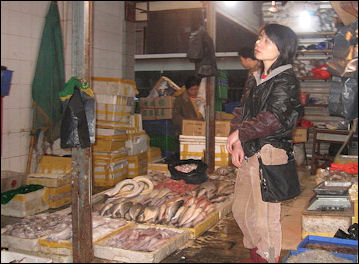
The Economist reported: “Supermarkets could cut prices if their supply chains were better-oiled. Moving food from farm to fork is a nightmare. China has few big farms. More than four-fifths of the rural population of 675m work on tiny plots. “Logistics, warehousing and shipping are still very inefficient,” says Chiang Jeongwen of the China-Europe International Business School in Shanghai. [Source: The Economist, May 19, 2011]
Distribution is a problem for retailers, There is no nationals freight carrier, Instead the 5 million truck operated by hundred of thousands of businesses. Delivery trucks that make long hauls often return empty because of lack of uniform regulations, Also, there’s no uniform system for tracking, issuing invoices or collecting payments by credit.
Figuring out a good strategy is a problem. Peter Foster wrote in The Telegraph, “In a country as vast as China, where levels of cultural exposure can differ hugely from place like Shanghai or Beijing to third and fourth-tier cities, there is no single solution: brands, as much as bands, will have to fight for their customers.” [Source: Peter Foster, The Telegraph, November 20, 2009]
“I think consumers in China today are undergoing an economic transformation and all consumer brands are battling for market share,” one analyst told The Telegraph. “Chinese consumers tend to be more experimental and less loyal, so you have to work to engage them in innovative ways.” [Source: Peter Foster,The Telegraph, November 20, 2009]
New Markets in Chinese Retailing
The Economist reported: “The next big thing for retailers in China will be the less-developed cities of the country’s interior. It’s a “land-grab”, says a Chinese executive. Everyone is vying for first-mover advantage. Yet although no one wants to arrive too late, no one wants to be too early, either. Those who open stores when locals are still too poor to shop there can lose a packet. [Source: The Economist, May 19, 2011]
The market has a Wild West feel. Huge areas of China are wide open, and it helps if you are chums with the local lawman. Retailers depend on local government for a licence and a place to operate. “The prime space always goes to local players,” says Sunny Wong, the boss of Lifung Trinity, a retailer. Tellingly, the Bailian Group, China’s biggest retailer, is state-owned.
“There could be political tensions if a foreign retailer gets too big or too dominant,” says Matthew Crabbe of Access Asia, a consultancy. There seems little danger of that. Neither Carrefour nor Walmart has much more than 6 percent of the market. Provincial governments favour provincial retailers. The national government gives a helping hand to all Chinese chains. Foreigners are on their own. Call it the Great Wall against Walmart.
Retailing in Shanghai
Shanghai has been the beachhead for foreign companies hoping to sell stuff in China. Jonathan Watts wrote in The Guardian, “While information firms and political lobbyists headed to Beijing and manufacturers flocked to Guangzhou, retail giants almost invariably chose Shanghai for their China headquarters and their first showrooms. From Kentucky Fried Chicken, McDonald's and Starbucks to Louis Vuitton, Gucci and Chanel, international brands made the city a giant shopping mall. [Source: Jonathan Watts, The Guardian, June 26, 2010, , edited from “When A Billion Chinese Jump” by Jonathan Watts Faber, 2010 ]
Retail markets have become less diverse as they have grown. Paul French, a Shanghai-based marketing consultant, told The Guardian the problem is that the shopping malls designed to create the image of a good life do not reflect reality for most people: “They are building more and more malls filled with luxury brands. Like the power stations in Soviet-era Russia, they are being built not because of demand but because of prestige. Every official in China wants one to show their city is on the international map.”
“These emporiums are designed to generate desire, not meet needs,” Watts wrote. “Many are dismissed by locals as gui gouwu zhongxin (ghost malls) because they attract so few customers. Yet in Shanghai they are everywhere. Xujiahui intersection, for example, is ringed by six department stores. Among them is the Orient Shopping Mall, boasting Estée Lauder cosmetics, Rolex watches, Cartier pens and Dior lipstick. Passing through the revolving door one weekday morning, I see not a single customer. Not even a window shopper.”
Foreign Retailers in China
Large retailers such as U.S.-based Wall-Mart, French-owned Carrefour, German-owned Metro AG and Thai-owned Lotus have moved into China in a big way. The Japanese convenience store Family Mart has plans to open up 3,000 stores and increase its totals to 10,000 stores. Owners say the market is big enough to handle 400,000 stores. Japan's Uniqlo hopes to have 1,000 stores in China by 2020.
Tesco, Britain’s largest retailer, is in China. Ikea has stores in Beijing and Shanghai. Seven-Eleven opened up its first store in Shenzhen in 2004 and hopes to have 100 stores there within a couple of years. Best Buy opened its first outlet in the Shanghai shopping district Xujiahui in China in December 2006. It has a partnership with Jiangsu Five Star Appliance Home Depot entered China in 2006 with acquisition of Homeway.
Who will conquer china’s rampant retail market? Probably no one. The Economist reported: “Foreign chains such as Carrefour, Walmart and Tesco are piling in. Yet none of them nor any of their local rivals comes close to dominating China as Walmart dominates the supermarket business in America. The largest chain, Shanghai Bailian, has only 11 percent of the market and barely registers outside its home region. Rules aimed at limiting expansion by foreign retailers limits the number of outlets of a retailer in certain geographical area. [Source: The Economist, May 19, 2011]
Successful and Unsuccessful American Retailers in China
KFC, for example, relying on a team of Taiwanese managers, has a locally designed menu for Chinese palates — congee, sesame-seed cakes, spicy chicken rice — that would be largely unrecognizable in the United States. Wal-Mart has succeeded with an expanded grocery business in its China stores, including markets for fresh produce.
In early 2011 Mattel announced it was closing is flagshop Barbie store in Shanghai after two years. Around the same time U.S.-based Home Depot and Best Buy said they were scaling back their operations in China. Keith B. Richburg wrote in the Washington Post: “Despite the potential, some firms have found profits here elusive. Analysts said the most successful American retailers in China are those that recognize the complexity of the market and adapt their products to local tastes and preferences. The Chinese are highly discerning consumers, experts say, and what works on Main Street does not always easily translate. [Source: Keith B. Richburg, Washington Post, May 10, 2011]
“Although Home Depot, Best Buy and Barbie each faced distinct challenges, retail analysts and others said the three cases carry some common, and familiar, threads: firms coming relatively late to an already-developed Chinese market, bringing products similar to widely available local brands, and finding it hard to differentiate their products, even though they may be well-known in the United States. “All three companies didn’t understand the Chinese market,” Shaun Rein, founder of China Market Research Group, a market intelligence firm in Shanghai, told the Washington Post . “They brought what worked in the United States and tried to ram it down the throats of Chinese consumers without much localization.” The key, he and others said, has been to adapt the product to the Chinese market and not try to adapt the market to the product.
Chinese consumers are also extremely price-conscious and are not always ready to pay even a few cents more for an American brand when a similar, less-expensive local model is available. At several Shanghai department stores, sales staff said the local Kurhn brand doll was generally outselling Barbie, largely because of price. And shoppers agreed. “Barbie is too expensive,” said Xu Xiaoyun, a 20-year-old college student who has been collecting dolls since she was young. She has one Barbie that she found on sale. “The blond hair and blue eyes are a little different from our standard of beauty,” she said. “It’s true Barbie has a long history, and the design and quality are better. But still, it’s expensive.”
“Home Depot arrived in China in 2006, buying a local home-improvement chain Home Way,” Ritchburg wrote, “but has struggled to find a foothold for its American-inspired concept of DIY, or “do it yourself.” In China, labor is cheap, and the notion of DIY is almost nonexistent for urban consumers who grew up with someone else on hand to do everything for them. “The DIY concept is too advanced for today’s Chinese people — Chinese society has not developed into that,” said Chen Can, an analyst for a Shanghai consultancy. Home Depot seemed to acknowledge as much, with a spokesman noting that relatively cheap labor costs mean Chinese consumers tend to work more with decorating companies or contractors when they renovate their homes. “In that sense, it is more about do-it-for-me rather than DIY,” the spokesman said in a written statement.”
Shortly after Home Depot’s announcement, Best Buy said that it was closing all of its outlets in China, and concentrating on expanding its wholly owned Chinese subsidiary, the Five Star appliance chain, painting the move as a shift in strategy, to sell its brands through its more profitable partner stores. But retail analysts said Best Buy came late to China, in 2007, and found the Chinese electronics appliance market saturated with local competitors, such as Guomei and Suning, which were well-entrenched. “The thing that always shocks Americans is the weight of the competition,” said Paul French, a Shanghai-based retail analyst and author. China, he said, “has electronics plazas in every town.”
Lu Buchen, an independent appliance industry analyst, said Best Buy also brought U.S. business practices to a local market, where it found itself undercut by competitors using what he termed “gray area” practices. For example, Lu said, Chinese chains typically do not pay suppliers until after their products have been sold off the shelves. Best Buy, by contrast, paid suppliers up front, regardless of how the products sold. Also, in Chinese stores, brand suppliers pay sales staff to push their products on consumers, while Best Buy’s staff took a more neutral approach. Best Buy in the United States also makes a significant amount of revenue from the warranties it sells on its products. But as several industry analysts noted, consumers in China typically do not buy warranties.
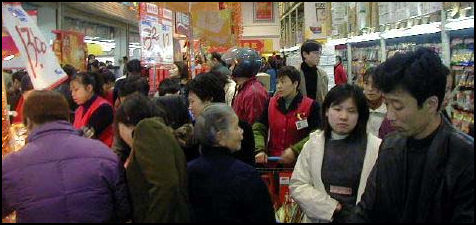
Busy Chinese supermarket
IKEA in China
The IKEA outside of Beijing has become a popular outing destination for local residents, who often don’t buy anything but are not shy about making themselves comfortable with a good book on the sofa and climbing under the covers of the beds and taking a nap. [Source: Los Angeles Times]
Some Chinese drive an hour and a half to soak up the IKEA vibes. One 34-year-old office worker who took his family to the store told the Los Angeles Times, “We just came here for fun. I suppose we could have gone somewhere else, but it wouldn’t have been a complete experience.” A 23-year-old woman who came with her boyfriend, mother and sister said, “We’ve heard a lot about IKEA but never came. I like the simplicity. My mom likes the food. We’ll hang out for a while.”
Many visitors enjoy cheap lunches at the IKEA cafeteria and pose for group pictures in front of the most eye-catching displays in the store. Some bring carpenters to take careful measurements of the furniture so they can make copies of them. Some mother bring toys for their kids to play with and let their kids jump on the couches. Others, resting on the beds, tell people passing by things like bed are “soft and a great buy for the price.” The mangers at IKEA endure the freeloading behavior to build a positive brand image, with the hope that in future when these freeloaders have money they will use it to buy IKEA products.
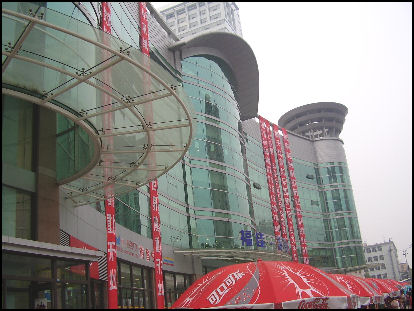
Carrefour store
Carrefour in China
French-owned Carrefour, the world’s No.2 retailer, is the largest foreign retailer in China. Carrefour had 156 hypermarkets and superstores as of 2010 up from 95 in 32 cities as of 2006. Sales that year rose 53 percent to $3.2 billion, making it China’s 5th largest retailer that year. China's hypermarket sector is forecast to grow at a compounded annual rate of 10.1 percent between 2010 and 2015, according to Euromonitor. But price competition is particularly tough in that segment.
Carrefour has adapted itself to Chinese tastes. Its stores initially offered 20 kinds of French wine but most of the bottles went unsold. It turns out $12 a bottle was too much. They had better success selling local wines fir $1. It has also has success selling local favorites like roasted mutton, horsemeat and 20 vanities of raisin in Uighur areas.
Carrefour was the first foreign retailer in China, in 1995,beatingout Wal-mart by a few months. It has attributed some of its success to bypassing Beijing and making deals directly with local government officials, who generally were pleased as punch to have the taxes, jobs and rent the stores brought.
Later Beijing got wind of what Carrefour was doing and created obstacles but by that time Carrefour had locked up some of the key sites in cities like Shanghai while Wal-Mart was relegated to the remote suburbs. When Wal-mart opened up its first store in Shanghai Carrefour already had 10 stores there
In 2007 Carrefour opened 23 new hypermarkets and Wal-mart opened 30. Both have more than 100 stores with at least 5,000 square meters of floor space.
Carrefour is looking to expand through the acquisition of other retail chains as Wal-mart has done.
Gome and Huang Guangyu
Gome Electrical Applianceis China's second-largest retailer by stores. It used to be No.1 Suning is China's largest retailer, with about 1,300 stores. It aggressively expanded in 2010 to take the ranking away from Gome. Gome was the top retailer in China in 2006 with sales of around $10 billion. It has has 700 outlets in 210 cities.
Huang Guangyu, the founder and chairman of Gome, was named by Forbes as the richest man in China in 2006 with a net worth of $2.3 billion when he was only 37. Known in China as the “price butcher,” he had an estimated worth of $1.7 billion in 2005. In 2007 he was only the 10th richest man even though his net worth increased by 50 percent from the previous year to $3.6 billion. In 2008, the Chinese press crowned him the nation’s richest man, with an estimated net worth of $6.3 billion. Forbes magazine’s list of the wealthy placed his assets at a more modest $2.7 billion.
In 2008, Huang Guangyo (also spelled Wong Kwongyu) was listed by Forbes in 2008 as China’s second richest person with a net worth of $2.7 billion. Other sources have estimated his wealth to be $6.3 billion. He and his wife, Du Juan, who is the company’s executive director, hold a 39.8 percent stake in Gome’s Listed unit.
Huang’s personal story had epitomized the can-do spirit and canny business acumen that have been trademarks of China’s swift rise to economic prominence. The younger of two brothers in a farming family in Guangdong Province, he was said in Chinese news reports to have spent part of his childhood trolling through trash bins for usable goods and began his business career selling plastic bottles and newspapers with his brother. When he was 16, armed with just a 9th grade education and $500 in seed money, he set up a roadside stall in Beijing to sell radios and gadgets that he purchased from factories near his home town in southern China. Huang came from Guangdong, an area rife with pirated goods, and went to Inner Mongolia, where almost everything was in short supply, Wu Alun, who wrote a 2005 book about Huang told the New York Times. That was where his first business ideas were formed: Take things from where they are plentiful to where they’re scarce. [Source: Michael Wines, New York Times, May, 18, 2010]
Later Huang set up an appliance distribution firm with $4,400 (4,000 renminbi they had earned as traveling salesmen in Inner Mongolia and a 30,000-renminbi loan). and founded GOME in 1987. Beating out rivals with cheap prices, he expanded quickly and was able to grow fast in the 1990s with relatively little competition. Huang became fabulously wealthy by floating his company on the Hong Kong stock market in 2004, then investing in real estate and stock in mainland China.
As of the mid 2000s, Huang’s Hong Kong-listed Gome (pronounced Gwo-may) Electrical Appliance Holdings ran 420 stores and employed about 300,000 people. To head off competition from Wal-Mart and Best Buy and others it launched an aggressive expansion campaign in which it opened hundreds of new stores, mostly through the acquisition of smaller retailers. Gome Electrical Appliance was the top retailer in China in 2006 with sales of around $10 billion. At its peak, Gome was China’s largest retail appliance chain, with 1,350 stores in more than 200 cities.
Trouble for Huang Guangyo
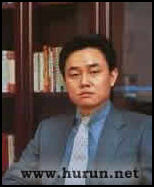 Things began to go wrong for Huang when he sought in 2006 to take over the troubled company that runs Zhongguancun, northern Beijing’s computer technology district, This move he attracted the attention of investigators.
Things began to go wrong for Huang when he sought in 2006 to take over the troubled company that runs Zhongguancun, northern Beijing’s computer technology district, This move he attracted the attention of investigators.
In 2006 and 2007, Huang was investigated and cleared on charges stemming from a shady real estate and loan deal made in the 1990s. The primary allegations was that Huang took a $167 million loan from the Bank of China Beijing branch without going through normal procedures and never paid it back. There were worries that Huang would be sent prison and his business empire would collapse. When it was announced that he had been cleared and the investigation was over, Gome stock soared 14.6 percent.
In November 2008, Huang Guanyo was detained on suspicion of market manipulation, and other crimes in connection with share trading violations involving a company controlled by his brother. Huang disappeared and was detained a week before there was any news of his whereabouts. Trade of Hong-Kong-listed shares of his company were suspended. In August 2009, a Hong Kong court ordered the freeze of $214 million of assets.
In 2008 the Chinese Securities Regulatory Commission accused Huang of manipulating the price of stock in a company, Beijing Centergate Technologies, so that profits from share sales could be used to restructure the company. Investigators later charged that Huang had paid about $680,000 in bribes to five top tax and police officials for help in tax disputes. Huang’s rise, Wu said, may also have epitomized the corporate style in modern China, where seeking political favor and protection are sometimes viewed more as sharp business tactics than as acts of wrongdoing. The chances of being investigated, other analysts routinely say, often depend on whether one has fallen from political favor. [Source: Michael Wines, New York Times, May, 18, 2010]
Huang Guangyo’s Arrest and Imprisonment
In June 2010, Huang Guangyu was found guilty of insider trading and illegal business dealings. He was sentenced to 14 years in prison and fined $88 million and had another $29 million worth of property confiscated.
In November 2008, Beijing public security officers detained Huang on suspicion of economic crimes. In the ensuing 17months, investigators accused him of bribing five senior tax and police officials, illegally converting 800 million renminbi, or $117 million, into foreign currency and insider trading involving the stock of a company in the city of Shenzhen that was said to have netted him about $45 million. [Source: Michael Wines, New York Times, May, 18, 2010]
Perhaps a dozen prominent people were reported in the Chinese press to have been caught up in the investigation, including Xu Zongheng, a onetime mayor of Shenzhen; the former police chief and the former top anticorruption official in southeastern China’s Guangdong Province; the deputy public security chief in Shanghai; and a major investor in Neptune Group, a cruise line and casino operator based in Hong Kong.
The state-run Xinhua news service, the only news agency allowed to witness the trial, reported that Huang’swife, Du Juan, was also convicted of insider trading and was sentenced to three years in prison and fined about $29 million.Two of the firms Huang once ran, Gome Electrical Appliances Holdings and Beijing Pengrun Real Estate Development, were fined $730,000 and $176,000 for paying bribes.
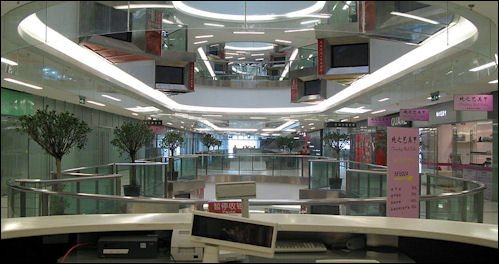
Empty Cloud Line Shopping Mall
Gome After Huang’s Arrest
Gome issued a statement saying it respected the court’s judgment and adding that the amount won’t materially affect the company’s business operations or financial position. Since its peak, Gome has closed hundreds of stores, and now has fewer than 700, but it remains profitable. [Source: Michael Wines, New York Times, May, 18, 2010]
Huang resigned as chairman of Gome two months after his detention. The company stated that no corporate funds were embezzled or used to pay bribes. Trading in Gome’s shares was suspended for some seven months after Huang’s detention but resumed about a year ago.
GOME has since been trying to separate itself from Huang, changing its logo, appointing a new chairman and selling a nearly 25 percent stake to U.S. private equity firm, Bain Capita, l for $418 million in June 2010. Two months later, Gome named three Bain executives to its board in a stated attempt to improve corporate governance, but the three were later ousted from the board.
U.S. private-equity firm Bain Capital is Gome's second-largest shareholder, with a nearly 10 percent stake, after Mr. Huang, who owns about 32 percent. [Source: Laurie Burkitt, Wall Street Journal, March 11, 2011]
Laurie Burkitt wrote in the Wall Street Journal: “Gome is entering an era of stability with its newly appointed chairman, Zhang Dazhong, the 62-year-old founder of Beijing Dazhong Electric Appliances Co., a onetime rival retailer Gome acquired in 2007. Analysts say Gome founder Huang Guangyu — now serving a 14-year sentence in a Chinese prison for bribery and other illegal business practices — has a secure relationship with Mr. Zhang that is unlikely to spark a
Under Zhang Gome is expected to expand rapidly. In September 2010 Huang said the company aims to operate 2,200 stores by 2015. The listed company currently runs nearly 800 stores. Gome's goal is to overtake competitor Suning, which aggressively expanded over the past year, becoming China's largest retailer, with about 1,300 stores.
From prison, Mr. Huang has sought to increase his family's control of the company. In late September, Mr. Huang attempted to have his younger sister unseat Mr. Chen, but shareholders narrowly rejected the resolution. Mr. Huang's wife, Du Juan, who was released from prison last year after serving time for insider trading, attended a recent board meeting.
Image Sources: 1)Poco Pico blog; 2) Wall Mart Watch; 3) Picasaweb; 4) Clarkson blog ; 5) Shopdair; 6) Bloomberg ; Wiki Commons
Text Sources: New York Times, Washington Post, Los Angeles Times, Times of London, National Geographic, The New Yorker, Time, Newsweek, Reuters, AP, Lonely Planet Guides, Compton’s Encyclopedia and various books and other publications.
Last updated February 2012
